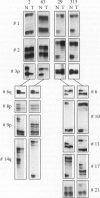Abstract
Recent application of molecular cytogenetic techniques has resulted in a new type of genetic classification of renal cell tumors. The key aspect of the novel diagnostic concept is reflected by biologically distinct entities, each characterized by a specific combination of genetic changes. To work out a diagnostic/prognostic approach, we have applied polymorphic microsatellite markers for a quick analysis, based on polymerase chain reaction, of 82 tumor specimens. We compared the results to previously evaluated cytogenetic and histological data. All nonpapillary and chromophobe renal cell carcinomas, which make up approximately 90% of all malignant renal cell tumors, and a subset of renal oncocytomas were correctly diagnosed by detection of loss of heterozygosity at chromosomal sites 1, 2, and 3p. Allelic losses at chromosomal regions 8p, 9p, and 14q are associated with an advanced pathological stage of nonpapillary renal cell carcinomas. A loss of heterozygosity at chromosomes 6, 10, 13, 17, and 21, in addition to those at chromosomes 1 and 2, confirm the diagnosis of chromophobe renal cell tumors. Using this approach, the differential diagnosis of renal cell tumors could be carried out within 1 or 2 days.
Full text
PDF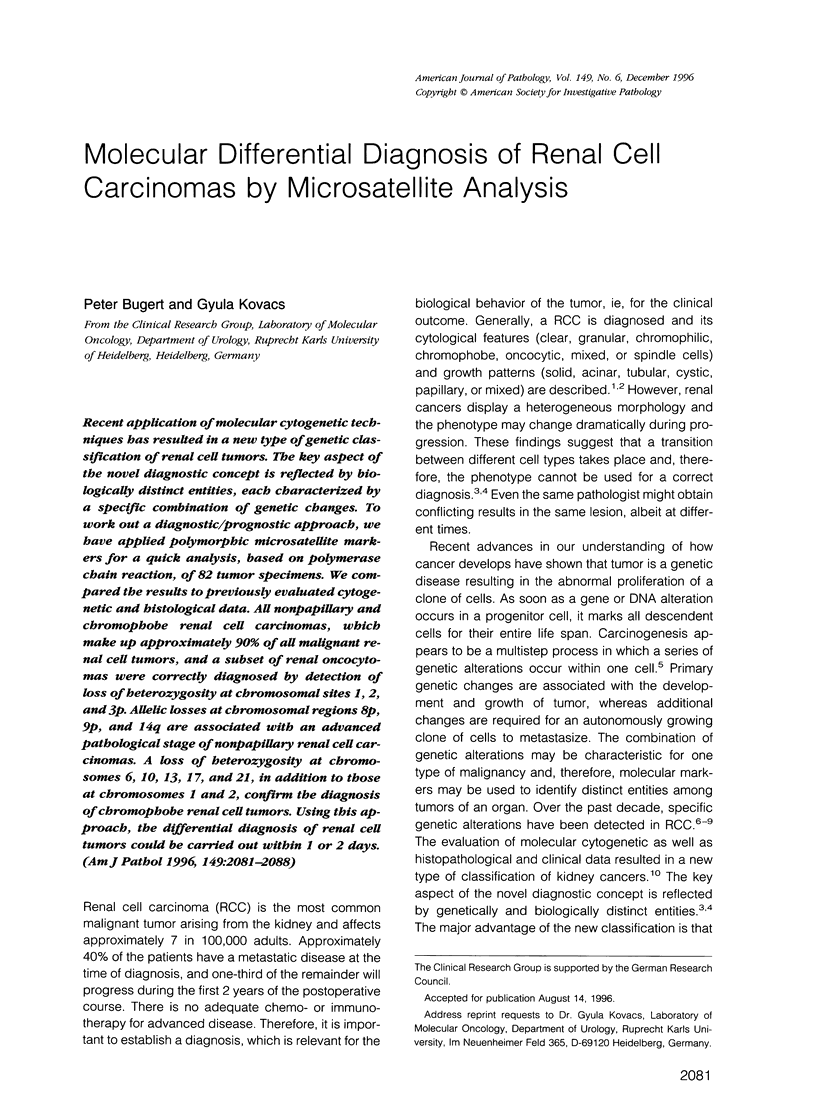
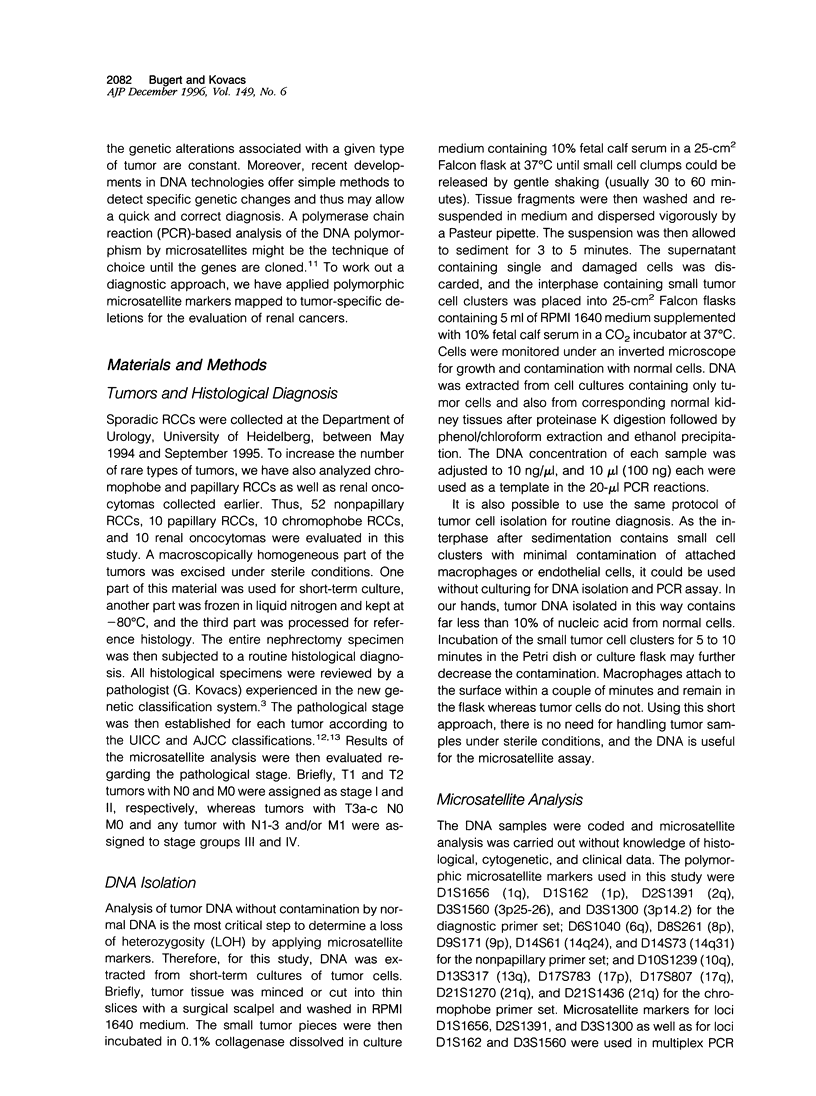
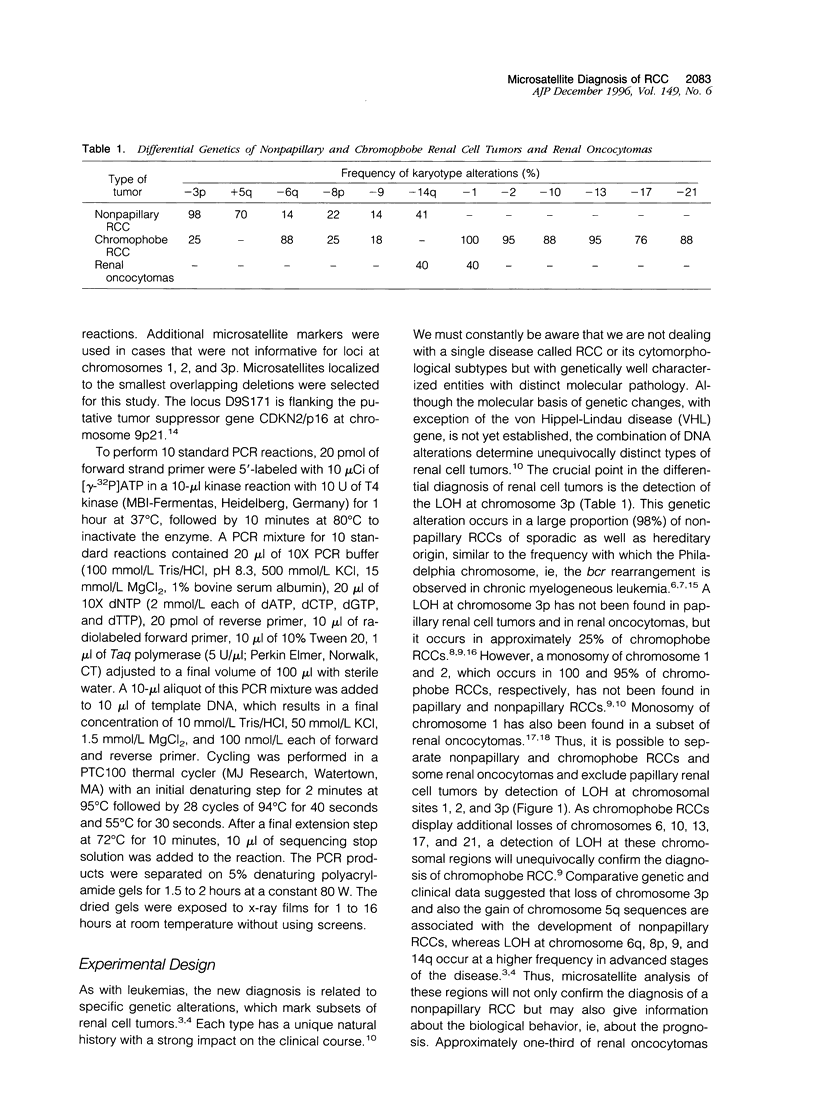
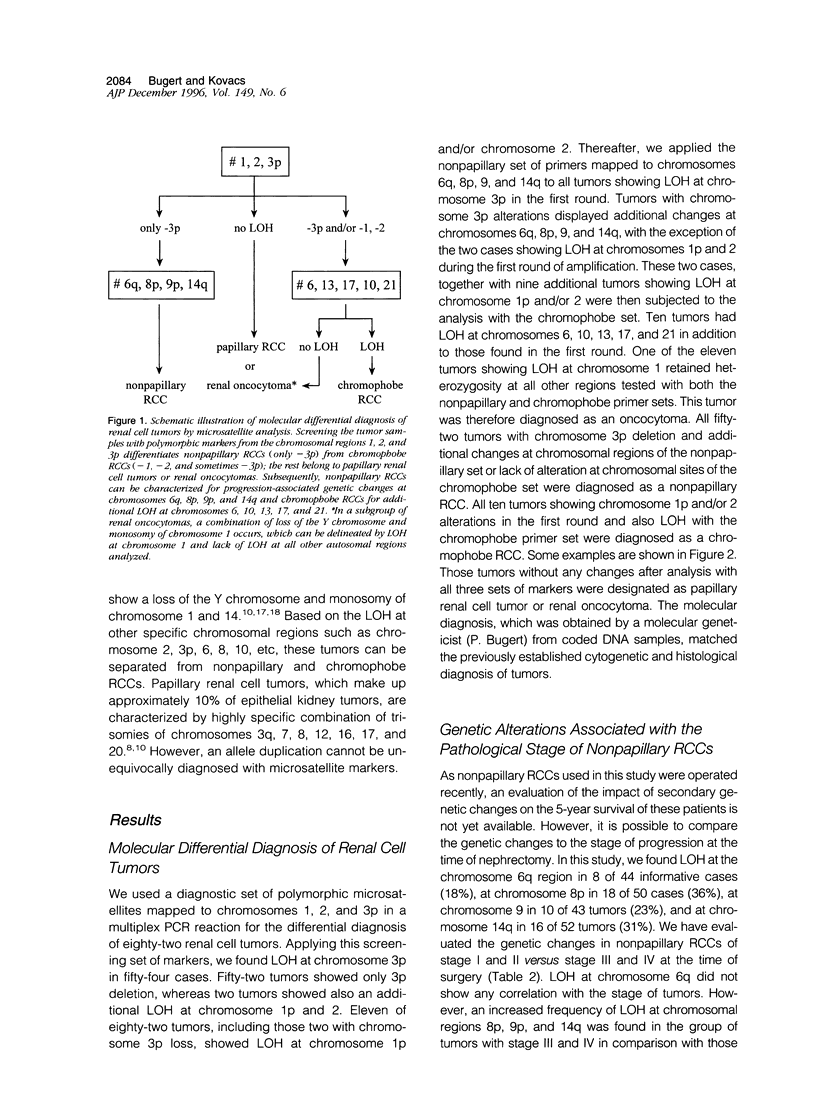
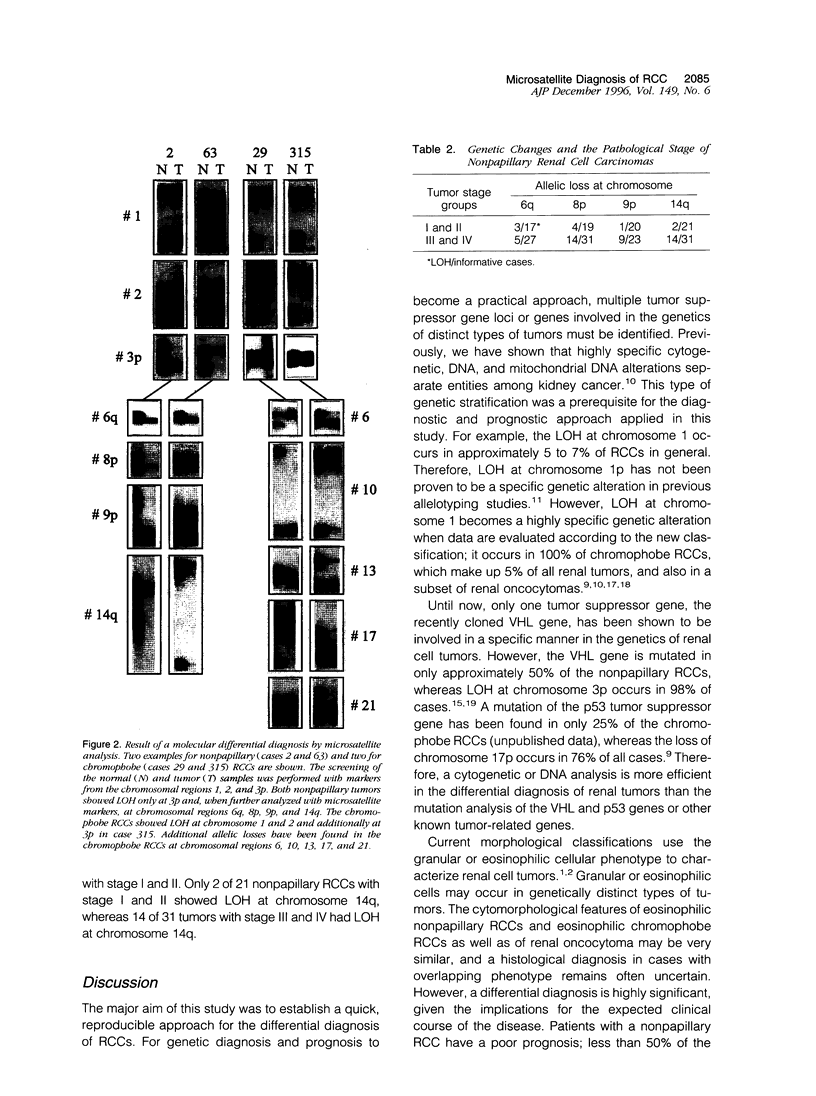

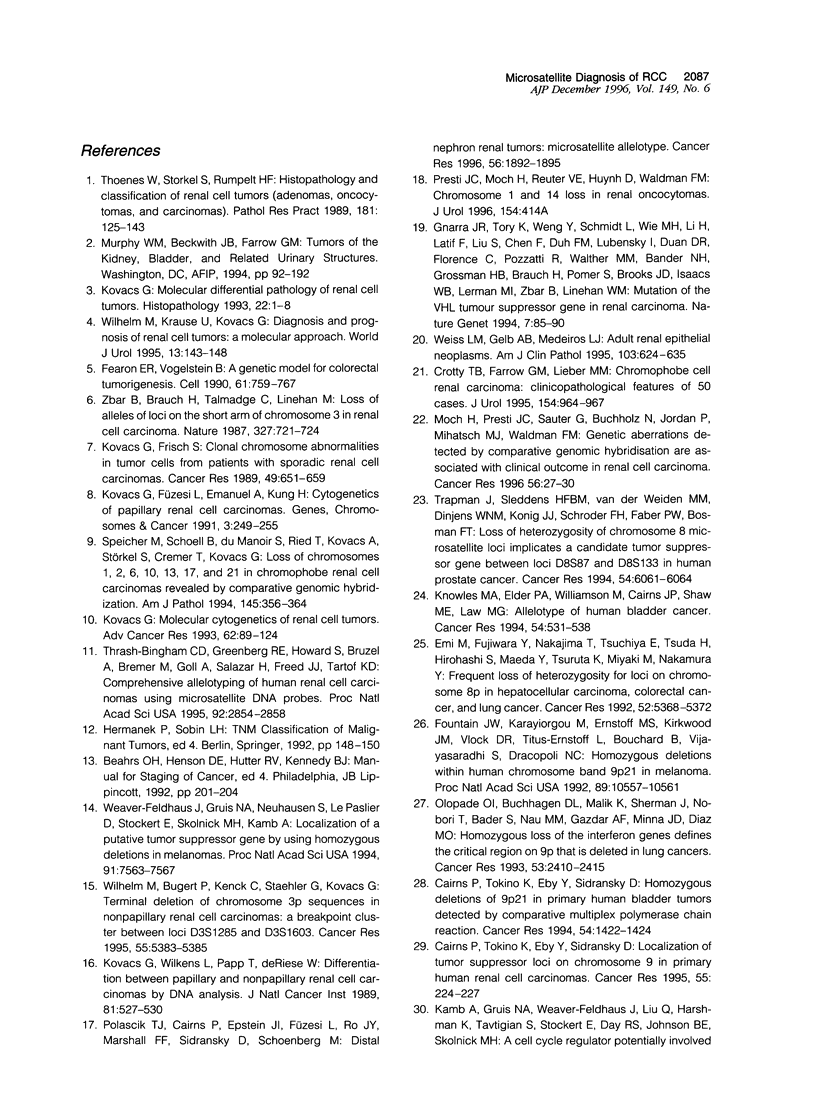

Images in this article
Selected References
These references are in PubMed. This may not be the complete list of references from this article.
- Cairns P., Tokino K., Eby Y., Sidransky D. Homozygous deletions of 9p21 in primary human bladder tumors detected by comparative multiplex polymerase chain reaction. Cancer Res. 1994 Mar 15;54(6):1422–1424. [PubMed] [Google Scholar]
- Cairns P., Tokino K., Eby Y., Sidransky D. Localization of tumor suppressor loci on chromosome 9 in primary human renal cell carcinomas. Cancer Res. 1995 Jan 15;55(2):224–227. [PubMed] [Google Scholar]
- Chang W. Y., Cairns P., Schoenberg M. P., Polascik T. J., Sidransky D. Novel suppressor loci on chromosome 14q in primary bladder cancer. Cancer Res. 1995 Aug 1;55(15):3246–3249. [PubMed] [Google Scholar]
- Crotty T. B., Farrow G. M., Lieber M. M. Chromophobe cell renal carcinoma: clinicopathological features of 50 cases. J Urol. 1995 Sep;154(3):964–967. doi: 10.1016/s0022-5347(01)66944-1. [DOI] [PubMed] [Google Scholar]
- Emi M., Fujiwara Y., Nakajima T., Tsuchiya E., Tsuda H., Hirohashi S., Maeda Y., Tsuruta K., Miyaki M., Nakamura Y. Frequent loss of heterozygosity for loci on chromosome 8p in hepatocellular carcinoma, colorectal cancer, and lung cancer. Cancer Res. 1992 Oct 1;52(19):5368–5372. [PubMed] [Google Scholar]
- Fearon E. R., Vogelstein B. A genetic model for colorectal tumorigenesis. Cell. 1990 Jun 1;61(5):759–767. doi: 10.1016/0092-8674(90)90186-i. [DOI] [PubMed] [Google Scholar]
- Fong C. T., White P. S., Peterson K., Sapienza C., Cavenee W. K., Kern S. E., Vogelstein B., Cantor A. B., Look A. T., Brodeur G. M. Loss of heterozygosity for chromosomes 1 or 14 defines subsets of advanced neuroblastomas. Cancer Res. 1992 Apr 1;52(7):1780–1785. [PubMed] [Google Scholar]
- Fountain J. W., Karayiorgou M., Ernstoff M. S., Kirkwood J. M., Vlock D. R., Titus-Ernstoff L., Bouchard B., Vijayasaradhi S., Houghton A. N., Lahti J. Homozygous deletions within human chromosome band 9p21 in melanoma. Proc Natl Acad Sci U S A. 1992 Nov 1;89(21):10557–10561. doi: 10.1073/pnas.89.21.10557. [DOI] [PMC free article] [PubMed] [Google Scholar]
- Gnarra J. R., Tory K., Weng Y., Schmidt L., Wei M. H., Li H., Latif F., Liu S., Chen F., Duh F. M. Mutations of the VHL tumour suppressor gene in renal carcinoma. Nat Genet. 1994 May;7(1):85–90. doi: 10.1038/ng0594-85. [DOI] [PubMed] [Google Scholar]
- Knowles M. A., Elder P. A., Williamson M., Cairns J. P., Shaw M. E., Law M. G. Allelotype of human bladder cancer. Cancer Res. 1994 Jan 15;54(2):531–538. [PubMed] [Google Scholar]
- Kovacs G., Frisch S. Clonal chromosome abnormalities in tumor cells from patients with sporadic renal cell carcinomas. Cancer Res. 1989 Feb 1;49(3):651–659. [PubMed] [Google Scholar]
- Kovacs G., Fuzesi L., Emanual A., Kung H. F. Cytogenetics of papillary renal cell tumors. Genes Chromosomes Cancer. 1991 Jul;3(4):249–255. doi: 10.1002/gcc.2870030403. [DOI] [PubMed] [Google Scholar]
- Kovacs G. Molecular cytogenetics of renal cell tumors. Adv Cancer Res. 1993;62:89–124. doi: 10.1016/s0065-230x(08)60316-4. [DOI] [PubMed] [Google Scholar]
- Kovacs G. Molecular differential pathology of renal cell tumours. Histopathology. 1993 Jan;22(1):1–8. doi: 10.1111/j.1365-2559.1993.tb00061.x. [DOI] [PubMed] [Google Scholar]
- Kovacs G., Wilkens L., Papp T., de Riese W. Differentiation between papillary and nonpapillary renal cell carcinomas by DNA analysis. J Natl Cancer Inst. 1989 Apr 5;81(7):527–530. doi: 10.1093/jnci/81.7.527. [DOI] [PubMed] [Google Scholar]
- Moch H., Presti J. C., Jr, Sauter G., Buchholz N., Jordan P., Mihatsch M. J., Waldman F. M. Genetic aberrations detected by comparative genomic hybridization are associated with clinical outcome in renal cell carcinoma. Cancer Res. 1996 Jan 1;56(1):27–30. [PubMed] [Google Scholar]
- Olopade O. I., Buchhagen D. L., Malik K., Sherman J., Nobori T., Bader S., Nau M. M., Gazdar A. F., Minna J. D., Diaz M. O. Homozygous loss of the interferon genes defines the critical region on 9p that is deleted in lung cancers. Cancer Res. 1993 May 15;53(10 Suppl):2410–2415. [PubMed] [Google Scholar]
- Polascik T. J., Cairns P., Epstein J. I., Fuzesi L., Ro J. Y., Marshall F. F., Sidransky D., Schoenberg M. Distal nephron renal tumors: microsatellite allelotype. Cancer Res. 1996 Apr 15;56(8):1892–1895. [PubMed] [Google Scholar]
- Speicher M. R., Schoell B., du Manoir S., Schröck E., Ried T., Cremer T., Störkel S., Kovacs A., Kovacs G. Specific loss of chromosomes 1, 2, 6, 10, 13, 17, and 21 in chromophobe renal cell carcinomas revealed by comparative genomic hybridization. Am J Pathol. 1994 Aug;145(2):356–364. [PMC free article] [PubMed] [Google Scholar]
- Thoenes W., Störkel S., Rumpelt H. J. Histopathology and classification of renal cell tumors (adenomas, oncocytomas and carcinomas). The basic cytological and histopathological elements and their use for diagnostics. Pathol Res Pract. 1986 May;181(2):125–143. doi: 10.1016/S0344-0338(86)80001-2. [DOI] [PubMed] [Google Scholar]
- Thrash-Bingham C. A., Greenberg R. E., Howard S., Bruzel A., Bremer M., Goll A., Salazar H., Freed J. J., Tartof K. D. Comprehensive allelotyping of human renal cell carcinomas using microsatellite DNA probes. Proc Natl Acad Sci U S A. 1995 Mar 28;92(7):2854–2858. doi: 10.1073/pnas.92.7.2854. [DOI] [PMC free article] [PubMed] [Google Scholar]
- Trapman J., Sleddens H. F., van der Weiden M. M., Dinjens W. N., Konig J. J., Schroder F. H., Faber P. W., Bosman F. T. Loss of heterozygosity of chromosome 8 microsatellite loci implicates a candidate tumor suppressor gene between the loci D8S87 and D8S133 in human prostate cancer. Cancer Res. 1994 Dec 1;54(23):6061–6064. [PubMed] [Google Scholar]
- Weaver-Feldhaus J., Gruis N. A., Neuhausen S., Le Paslier D., Stockert E., Skolnick M. H., Kamb A. Localization of a putative tumor suppressor gene by using homozygous deletions in melanomas. Proc Natl Acad Sci U S A. 1994 Aug 2;91(16):7563–7567. doi: 10.1073/pnas.91.16.7563. [DOI] [PMC free article] [PubMed] [Google Scholar]
- Weiss L. M., Gelb A. B., Medeiros L. J. Adult renal epithelial neoplasms. Am J Clin Pathol. 1995 May;103(5):624–635. doi: 10.1093/ajcp/103.5.624. [DOI] [PubMed] [Google Scholar]
- Wilhelm M., Bugert P., Kenck C., Staehler G., Kovacs G. Terminal deletion of chromosome 3p sequences in nonpapillary renal cell carcinomas: a breakpoint cluster between loci D3S1285 and D3S1603. Cancer Res. 1995 Nov 15;55(22):5383–5385. [PubMed] [Google Scholar]
- Wilhelm M., Krause U., Kovacs G. Diagnosis and prognosis of renal-cell tumors: a molecular approach. World J Urol. 1995;13(3):143–148. doi: 10.1007/BF00184868. [DOI] [PubMed] [Google Scholar]
- Young J., Leggett B., Ward M., Thomas L., Buttenshaw R., Searle J., Chenevix-Trench G. Frequent loss of heterozygosity on chromosome 14 occurs in advanced colorectal carcinomas. Oncogene. 1993 Mar;8(3):671–675. [PubMed] [Google Scholar]
- Zbar B., Brauch H., Talmadge C., Linehan M. Loss of alleles of loci on the short arm of chromosome 3 in renal cell carcinoma. 1987 Jun 25-Jul 1Nature. 327(6124):721–724. doi: 10.1038/327721a0. [DOI] [PubMed] [Google Scholar]



